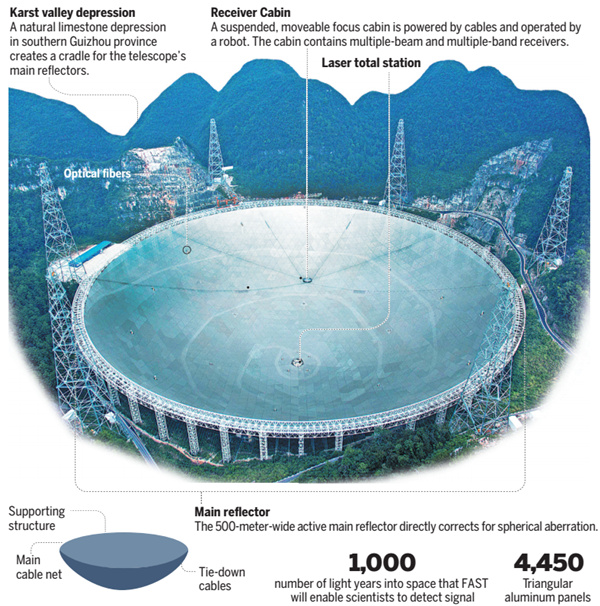World's largest telescope begins peering into space
Updated: 2016-09-26 01:59
By YANG JUN, HOU LIQIANG(China Daily)
|
||||||||
Dish as big as 30 soccer fields, in Guizhou, to push Chinese science to forefront
 |
|
Sources: Skyandtelescope.com, universetoday.com. URSI |
With the massive facility officially beginning to operate on Sunday, leading scientists told China Daily that foreign scientists will be welcome to use China's gigantic Five-hundred-meter Aperture Spherical Telescope, known as FAST.
It is a single-aperture telescope the size of 30 soccer fields, located in Guizhou province in southwestern China.
The facility, surpassing the second- largest by 200 meters in diameter, is being called a game-changer in space research.
President Xi Jinping on Sunday sent a congratulatory letter to the scientists and engineers who contributed to its creation.
"The launch of FAST symbolizes a major breakthrough in China's science research and has great significance for the country's strategy to push forward innovation," Xi said in the letter.
FAST will search for gravitational waves, detect radio emissions from stars and galaxies, and listen for signs of intelligent extraterrestrial life, scientists said.
"The ultimate goal of FAST is to discover the laws of the development of the universe," said Qian Lei, an associate researcher with the National Astronomical Observation, part of the Chinese Academy of Sciences, which built the telescope.
"In theory, if there is civilization in outer space, the radio signal it sends will be similar to the signal we can receive when a radiation beam from a pulsar (spinning neutron star) is approaching us," Qian said.
Zhang Shuxin, deputy general manager of the project, said foreign scientists can start conducting their own space research at FAST once debugging is completed.
But before that is done, "we wouldn't feel very good" to start distributing time slots to foreign astronomers, he said.
"It's such a huge thing, you see," Zhang said. "And the technologies we use in both its driving device and reflecting surface are entirely new to us."
"As the first step, a parabola of 300 meters in diameter will be formed on the surface, with the help of the driving device, and start receiving signals," he explained. "We need to gather experience and develop methodology to ensure detection accuracy for that."
It may be three to five years before FAST can guarantee its best performance, Zhang said.
FAST's large hemispheric surface is made up of 4,450 1.3-millimeter-thin reflecting panels, each weighing 427 to 482.5 kilograms. The first panel was installed in August 2015. Patching all the panels together took 11 months.
Sun Caihong, deputy chief engineer for FAST, said the telescope's operators will focus on strong radio sources already known to them. He said scientists are also expecting to make some progress in research by analyzing data they receive in the debugging.
Wang Qiming, chief engineer for FAST, said: "We would like to finish debugging quickly. FAST will be the world leader in 10 to 20 years. We would like to make full use of this period."
FAST already had a good start, scientists said. In a recent test, it received a set of high-quality electromagnetic waves sent from a pulsar about 1,351 light-years away.
It was the best-quality signal that FAST had received since it started its trial observation in mid-September.
Wang said the most challenging part of debugging is adjusting the laser that performs measuring tasks on the reflecting surface. As long as the laser measuring device detects errors in a timely way, scientists can make immediate adjustments.
The telescope is located in an almost-perfect spherical landform, so there was no need to dig a hollow for it. The valley in Guizhou was chosen also for its karst landform, which ensures good drainage, meaning rainwater won't gather and damage the reflecting surface of the telescope.
Philip Diamond, director-general of Square Kilometer Array, a large multiradio telescope project, said: "FAST is the biggest single dish in the world. It will have new technology, and a new receiver system, to be much more efficient. Astronomers and scientists are queuing up all around the word to use it."
Diamond said the SKA, an international project in which China is a member, will be even larger than FAST.
"But ours won't be in the form of one single dish. It will be hundreds and thousands of smaller dishes spread over a large area. They will work together," he said.
"You can think of FAST as a wide-angle lens and the SKA as a zoom lens. FAST will find a lot of objects, and SKA will offer a lot of details on these objects. They will be very complementary."
Anthony Beasley, director of National Radio Astronomy Observatory of the United States, said there are many areas of radio astronomy in which FAST will bring Chinese astronomers to the fore.
Beasley said it likely will be two to three years, while the telescope is brought to its full strength, before they use it.
Construction of the nearly 1.2 billion yuan ($180 million) FAST project started in 2011, 17 years after it was proposed by Chinese astronomers.
Contact the writers at houliqiang@chinadaily.com.cn
Xinhua and AP contributed to this story.
- Car-crazy Mexico City celebrates World Carfree Day
- Death toll rises to 52 after migrant boat capsizes off Egypt
- China and US should move forward regardless of election result
- Threat of 'lone wolf' terrorism rises: Aussie PM
- DPRK warns of retaliation against US, ROK
- US fighter jet crashes off coast of Okinawa, Japan: DM

 Li, Trudeau inaugurate 'new annual dialogue'
Li, Trudeau inaugurate 'new annual dialogue'
 Milan Fashion Week: Prada Spring/Summer 2017
Milan Fashion Week: Prada Spring/Summer 2017
 Panchen Lama prayers at foot of Qomolangma
Panchen Lama prayers at foot of Qomolangma
 Ai Fukuhara and her newlywed husband show up in Taiwan
Ai Fukuhara and her newlywed husband show up in Taiwan
 8 things you may not know about Autumn Equinox
8 things you may not know about Autumn Equinox
 Italian sets new record with Ferrari on 'miracle road'
Italian sets new record with Ferrari on 'miracle road'
 Students compete for flight attendant jobs in Sichuan
Students compete for flight attendant jobs in Sichuan
 1st Sushi restaurant opens in DPRK
1st Sushi restaurant opens in DPRK
Most Viewed
Editor's Picks

|

|

|

|

|

|
Today's Top News
Trump outlines anti-terror plan, proposing extreme vetting for immigrants
Phelps puts spotlight on cupping
US launches airstrikes against IS targets in Libya's Sirte
Ministry slams US-Korean THAAD deployment
Two police officers shot at protest in Dallas
Abe's blame game reveals his policies failing to get results
Ending wildlife trafficking must be policy priority in Asia
Effects of supply-side reform take time to be seen
US Weekly

|

|









